Relationship addiction, also known as love addiction, can devastate lives, just like substance abuse or gambling. This compulsive need for romantic relationships often stems from deep-seated emotional wounds and can lead to a cycle of toxic partnerships that’s hard to break.
Many people don’t realize they’re struggling with relationship addiction until they’ve experienced multiple failed relationships with similar patterns. The constant pursuit of romantic connections, personal validation, and emotional highs can interfere with daily life careers and mental health. It’s a behavioral addiction that affects millions yet remains primarily misunderstood and undertreated.
This complex psychological condition isn’t about being “too romantic” or simply enjoying relationships – it’s a severe issue that requires professional intervention and support. Understanding the signs, causes, and treatment options can help those affected break free from this destructive cycle and develop healthier relationship patterns.
Understanding Relationship Addiction
Relationship addiction manifests as an obsessive pattern of seeking romantic connections despite adverse consequences. The condition stems from neurobiological factors, including dopamine and oxytocin release, which create addictive responses to romantic interactions.
Signs and Symptoms
Critical indicators of relationship addiction include:
- Intense fear of being alone or single
- Prioritizing relationships over personal responsibilities
- Staying in unhealthy relationships despite obvious red flags
- Rushing into new relationships immediately after breakups
- Excessive validation-seeking from romantic partners
- Difficulty maintaining personal boundaries in relationships
- Neglecting friendships and family relationships for romantic partners
The Cycle of Dependency
The relationship addiction cycle follows distinct phases:
- Initial euphoria: Experiencing an intense high from new romantic connections
- Dependency formation: Developing an unhealthy reliance on the partner’s presence
- Emotional distress: Feeling anxiety and panic when separated from the partner
- Compulsive behavior: Engaging in desperate attempts to maintain the relationship
- Withdrawal symptoms: Experiencing physical and emotional symptoms during breakups
- Pattern repetition: Starting the cycle again with a new relationship partner
These distinct patterns mirror substance addiction cycles with similar neurobiological responses triggering compulsive behavior. The release of dopamine oxytocin during romantic interactions reinforces the addictive patterns, creating a persistent cycle of dependency.
Root Causes of Relationship Addiction

Relationship addiction stems from complex psychological factors rooted in early life experiences. These underlying causes create patterns that influence relationship behaviors throughout adulthood.
Childhood Trauma and Attachment Issues
Early traumatic experiences shape relationship patterns in adulthood. Childhood trauma manifests through:
- Physical or emotional abuse
- Parental neglect or abandonment
- Inconsistent caregiving
- Witnessing domestic violence
- Family substance abuse
Insecure attachment patterns develop from these experiences, leading to:
- Anxious-ambivalent attachment: Excessive dependency on partners
- Avoidant attachment: Fear of emotional intimacy
- Disorganized attachment: Inconsistent relationship behaviors
- Constant seeking of validation from romantic partners
- Difficulty maintaining healthy boundaries
Low Self-Esteem and Fear of Abandonment
Low self-worth drives compulsive relationship-seeking behaviors through:
- Excessive need for external validation
- Difficulty being alone
- Compromising personal values for relationship maintenance
- People-pleasing tendencies
- Accepting mistreatment from partners
- Intense anxiety when partners are unavailable
- Chronic worry about relationship stability
- Difficulty trusting partners
- Overanalyzing partner behaviors
- Reluctance to express needs or feelings
- Staying in unhealthy relationships to avoid being alone
| Impact Factor | Percentage of Affected Individuals |
|---|---|
| Childhood Trauma History | 75% |
| Insecure Attachment | 65% |
| Low Self-Esteem | 82% |
| Fear of Abandonment | 89% |
The Impact on Mental Health

Relationship addiction significantly disrupts mental well-being through a range of psychological challenges. Research indicates that individuals with relationship addiction experience higher rates of mental health disorders compared to the general population.
Depression and Anxiety
Depression manifests in relationship-addicted individuals through persistent feelings of worthlessness outside romantic connections. Common symptoms include:
- Intense mood swings when relationship status changes
- Persistent negative self-talk during periods of being single
- Sleep disturbances linked to relationship uncertainty
- Decreased appetite during relationship conflicts
- Social withdrawal when experiencing relationship difficulties
Anxiety presents through:
- The constant fear of abandonment
- Excessive checking of partner’s social media
- Physical symptoms like a rapid heartbeat in relationship situations
- Intrusive thoughts about partner’s faithfulness
- Difficulty concentrating on tasks due to relationship preoccupation
Loss of Personal Identity
Relationship addiction erodes individual identity through consistent patterns of self-neglect. Key manifestations include:
- Adopting a partner’s interests while abandoning personal hobbies
- Changing core values to match romantic interests
- Neglecting career goals to prioritize relationships
- Losing connection with family members
- Sacrificing personal boundaries to maintain relationships
- Excessive focus on partner’s needs
- Diminished sense of personal achievements
- Loss of independent decision-making abilities
- Decreased self-awareness
- Compromised personal values for relationship maintenance
| Mental Health Impact Statistics | Percentage Affected |
|---|---|
| Depression symptoms | 78% |
| Anxiety disorders | 65% |
| Identity dissolution | 82% |
| Social isolation | 71% |
Breaking Free from Relationship Addiction

Breaking free from relationship addiction requires establishing clear boundaries and developing a strong sense of self-worth. Recovery focuses on creating healthy relationship patterns through therapeutic approaches and lifestyle changes.
Setting Healthy Boundaries
Setting healthy boundaries involves establishing clear limits in relationships to protect emotional well-being. Essential boundary-setting practices include:
- Communicating personal needs directly without guilt or fear
- Identifying toxic relationship patterns from past experiences
- Learning to say “no” to unreasonable demands
- Maintaining separate interests outside of romantic relationships
- Creating space for personal growth through independent activities
- Establishing consistent routines that prioritize self-care
Developing Self-Love
Developing self-love forms the foundation for overcoming relationship addiction through intentional practices:
- Engaging in daily positive self-affirmations
- Practicing mindfulness meditation to increase self-awareness
- Pursuing personal interests independent of relationships
- Setting achievable goals in career and personal growth
- Creating a support network of friends and family
- Participating in individual therapy sessions
- Maintaining physical health through exercise and nutrition
- Celebrating personal achievements without external validation
- Journaling thoughts and feelings to track emotional patterns
- Learning to spend time alone comfortably
| Intervention Type | Success Rate | Timeline |
|---|---|---|
| Individual Therapy | 65% | 6-12 months |
| Group Support | 58% | 3-6 months |
| Couples Counseling | 45% | 8-14 months |
Professional Treatment Options

Professional treatment for relationship addiction combines specialized therapy approaches with structured support programs. These evidence-based interventions address underlying trauma patterns and emotional dependencies.
Therapy and Counseling
Individual psychotherapy forms the foundation of relationship addiction treatment. Cognitive Behavioral Therapy (CBT) helps identify unhealthy relationship patterns and rewire destructive thought processes. Therapists specializing in love addiction guide clients through the following:
- Trauma processing techniques to heal childhood wounds
- Boundary-setting exercises for relationship dynamics
- Self-worth-building activities independent of relationships
- Attachment style assessment treatment modifications
- Anxiety management strategies for abandonment fears
Dynamic psychotherapy sessions occur weekly for 6-12 months with a 65% success rate for sustained recovery—specialized trauma therapies like EMDR target deep-rooted emotional injuries contributing to addictive patterns.
Support Groups and Recovery Programs
Structured support programs provide community connection accountability during recovery. Key program elements include:
- 12-step fellowships (Sex and Love Addicts Anonymous)
- Weekly group therapy sessions with fellow recovery participants
- Multi-day intensive workshops with a relationship addiction focus
- Online support communities for ongoing encouraging
- Family therapy integration for improved relationship dynamics
Group-based interventions demonstrate a 58% success rate within 3-6 months of consistent participation. Programs require participants to:
- Maintain no-contact periods with romantic interests
- Complete daily recovery assignments and journaling
- Attend minimum weekly support meetings
- Work with sponsors or accountability partners
- Practice new coping skills and relationship boundaries
Combining professional therapy and structured support creates a comprehensive treatment approach addressing individual healing and community reinforcement.
| Treatment Type | Success Rate | Timeline |
|---|---|---|
| Individual Therapy | 65% | 6-12 months |
| Group Support | 58% | 3-6 months |
| Intensive Workshops | 72% | 2-4 weeks |
Building Healthy Relationships
Building healthy relationships requires establishing clear boundaries, developing emotional independence, and creating balanced connections. This section explores practical strategies for fostering healthier relationship patterns.
Establishing Independence
- Cultivate personal interests outside romantic relationships (hobbies, career goals, friendships)
- Practice emotional self-regulation through mindfulness techniques
- Develop financial independence by maintaining separate accounts
- Create personal space by scheduling regular alone time
- Maintain individual friendships separate from romantic partnerships
- Set achievable personal goals unrelated to relationships
- Build a support network beyond romantic connections
- Engage in self-improvement activities (education, skills development, fitness)
- Practice active listening without interrupting or offering solutions
- Share responsibilities equally between partners
- Maintain healthy physical boundaries
- Express needs clearly without manipulation or guilt
- Respect partner’s interests, time
- Address conflicts directly through open communication
- Schedule quality time while maintaining separate activities
- Monitor emotional investment to prevent codependency
- Establish mutual trust through consistent actions
- Share decision-making responsibilities equally
| Relationship Element | Unhealthy Pattern | Healthy Pattern |
|---|---|---|
| Communication | Constant Contact (24/7) | Regular, scheduled check-ins |
| Personal Space | The complete merger of lives | 40-60% individual activities |
| Decision Making | One partner dominates | Equal input from both partners |
| Emotional Support | Complete dependence | Multiple support sources |
| Time Management | 90% together time | 60% together, 40% separate |
Summary
Breaking free from relationship addiction requires commitment, dedication, and professional support. While the journey to recovery can be challenging, remember that healing is possible with the right resources and guidance.
Those struggling with relationship addiction can find hope in the various treatment options and support systems available today. Individuals can build more nutritious, sustainable relationships by focusing on self-growth, setting healthy boundaries, and developing a strong sense of self-worth.
The path to recovery starts with acknowledging the problem and taking that brave step toward change. With professional help and a supportive community, anyone affected by relationship addiction can create a more balanced and fulfilling life.



